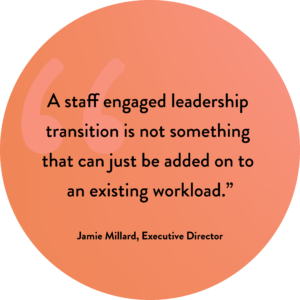
By: Jamie Millard
As Pollen continues through our Executive Director leadership transition (read about that here), every other week we will share more about our process, reflections, takeaways, and updates. “Bloom: Pollen’s Growth & Executive Director Transition Series” will candidly share how we’ve approached our process of executive leadership transition — a process that centers transparency, prevents harm, and is rooted in racial equity.
Special announcement: Learn even more about Pollen’s leadership transition on the I So Appreciate You! podcast.
When you pull one thread, other threads can start to unravel. This happened for Pollen once we really started digging into the implications of an executive director transition.
I think of this as facing the mess, turning towards all of the dust that you’ve been slowly sweeping under the rug over many years. I assume every organization has little lumps of dirt under their rug; I know Pollen definitely does. We’ve been in what feels like startup mode for almost a decade, and in this dance between survival and growth, sometimes our habits, our structures get a bit lumpy.
Like a potato left in a dark cabinet, growing offshoots here and there. When you discover the potato, and bring it into the light, the lumps might look a little startling, maybe slightly grotesque. Maybe you’re embarrassed that you left a potato in the cabinet so long that it grew aberrations. Maybe you close the cabinet and leave the potato in the dark. Maybe you hold the potato, appreciate its new growths, and cut it up for a stew.

Clean Out the Cabinets
For many organizations, the time of leadership change is a beautiful opportunity to pause, to look up, to reorient our perspectives. That is, if we can give in to the slowness that is required to clean out our cabinets. For Pollen, we knew pretty quickly that we wouldn’t be able to ignore some of the items that had been building up—especially with guiding outcomes like:
- Ensuring every decision is made with the ultimate goal of setting up the next executive director for maximum success;
- Nurturing and center current staff throughout the process;
- Embedding racial equity at every step; and
- Building trust between board and staff.
We wouldn’t be able to clean out every cabinet, find every little potato, or dust out all of our rugs, and that’s okay. But we could prioritize. What needs could be meaningfully addressed as part of our leadership transition that would most serve our ideal outcomes?
For Pollen, three main needs surfaced:
1. Tend to our organizational structure
2. Invest in the current staff
3. Grow our capacity

Do the Next Right Thing
Just like Anna in Frozen II, we set out to do The Next Right Thing and address these overdue, growing needs.
We tackled these three priorities through our joint staff and board Leadership Expansion Working Group. While this group was initially charged with guiding our executive director transition, it evolved to become more expansively focused on preparing our organization for growth, for its next era. In hindsight, this was a key ingredient to the success of the entire endeavor. The working group had the opportunity to practice collaborative problem-solving and taste the delicious momentum of success. Each time we solved one of these need areas, we gained confidence in our trust between staff and board. We were strengthening our ability to work together, to imagine together — all muscles this working group will eventually flex during the executive director transition.
Tending to our organizational structure
Pollen’s structure was a bit messy, a bit organic. Imagine an org chart duct-taped together through years of survival and growth. For example, almost every position in the organization reported directly to me — like a wad of sticky gum that haphazardly collects everything it comes in contact with. I’m embarrassed to admit that out loud, but it’s one of those things that worked for me (kind of). But I knew that if we were to set up the next leader for maximum success, they could not inherit 10+ direct reports.
We peeled off all the layers, objectively looked at it all, and reconfigured our structure to be more streamlined and positioned for scale. This was our first big win on this journey and it took about a year to complete.
Investing in the current staff
During leadership transitions, most of the focus is on discussions about the qualities and attributes that could be brought in by the next leader. As Pollen began down this path early on, our board chair, Sarah Clyne, advised, “Before we spend too much time dreaming of what’s next for the executive director, let’s make sure to tend to our current team.”
Imagine you’ve been part of a staff that has built brick by brick an organization to be positioned and ready for this growth. And then all of the discussions about how to grow for the future are centered around the next executive director. It wouldn’t feel great. Through informal discussions with other organizations that had been through leadership transitions, we heard loud and clear a consistent sentiment from staff: “I felt looked over,” “I felt under-appreciated,” “what about all that we have been doing,” “what about me?”
We knew that investing in our current staff was the right thing to do. To recognize all of the accomplishments and achievements they had manifested so far. To check-in with them on their wants and dreams. Do they feel fulfilled? Is there growth they want in their role at Pollen? Beyond Pollen?
We ended up reworking almost every person’s job description to be aligned with not only the restructure but with the growth and purpose that would be meaningful to each team member. And just as executive compensation is addressed for a next leader, we addressed compensation increases throughout the organization as well to show our team how valuable, critical, and important they are.
Growing our capacity
We had been dealing with capacity crunches for years — a result of increasing demand for our storytelling services combined with chronic exhaustion across current staff that had been building since 2020. We needed to add team members. As part of the restructuring, we identified where these additions were most needed and penciled in our plans for hiring.
Additionally, we recognized the added toll that change management would have on our team. A staff engaged leadership transition is not something that can just be added on to an existing workload. Something needs to go.
Sometimes that exchange means pausing program outputs, or delegating responsibilities, or hiring new team members. Pollen did a bit of all of the above. And we’re still going. By the time we’re done with this initial growth phase, we will have aimed to increase our capacity by about 80%.

Don’t Look Away
I’m so thankful Pollen didn’t ignore the potatoes in our cabinet. In the process, we learned so much about our team and our history. We appreciated where we’ve been before, and by not looking away, leaned into our strength of doing the next right thing.
Possible question prompts to reveal hidden (or maybe obvious) needs in your organization:
- What’s something we would be embarrassed for the next executive director to inherit?
- What knots are causing low morale, or even trauma, for staff?
- If we had a transformative amount of resources and time, what would we implement first?
- What obstacles or barriers need to be released? These could be feelings or programs.

What’s up next in “Bloom: Pollen’s Growth & Executive Director Transition Series”
Stay tuned for our next installment on October 26.
And listen here for even more about our intentional leadership transition on the Saint Paul Minnesota Foundation’s, I So Appreciate You podcast.

